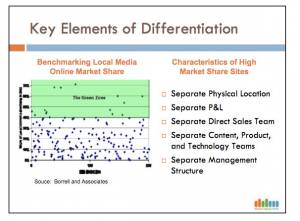Three questions to answer before 2012
As 2011 draws to a close, attention tends to focus in around concrete plans and budgets. Here are three larger questions that are harder to tackle mid-year, when budgets and plans have already been made. Every local media company should answer these before plans for 2012 are finalized.
1. Has your company adequately addressed the "separate or perish" issue?
It's clear - and you ignore this logic at your own risk - that businesses in all industries, and even good ones, even yours, do not survive technological disruption without some form of separate business unit reporting to a separate c-level executive. That is, none in the past. And if you would like to stake your company and professional life on the idea that your company and industry is somehow different, you don't need to keep reading.
So the question is, what have you separated, in terms of a product and sales division with separate reporting? An is it enough to propel real gains in digital market share in the local market?
Below, again, is the famous powerpoint that shows up at almost every media conference; the "green zone" are local media with significant digital market share, and their common characteristics, in Borrell & Associates study:
So the question is, what is your company setting up to drive separate revenue streams, what will drive marketshare in the future, and how will this be accomplished?
2. Do you have the right people?
As I often hear from successful executives, 49% of the success is the right strategy but 51% is the right people. Is your executive team in charge of digital revenues driven and creative about evolving new business models? If your company is a puerplay, are key people willing to go into the community and mix it up with the Chamber of Commerce or the Rotary Cub? Launch a street team?
If your company is a traditional media company, do you have a team who not only adopts best practices but expands and improves on strategies? Would this site want to cover some of their initiatives? Do they come up with any?
If you don't have the right people, who do you need to hire and when will you do it?
3. Do you have a working long term business model?
At bare minimum your company should have a target for growth of digital revenues. Many top companies are planning to hit a target of 50% to 60% growth in digital revenues in 2012, typically up from around 10% of total revenues to 20%. That's a serious target.
But it is still an incremental target, not a model, whose value is judged by its total long term potential. Doubling banner ads won't make a dent in the problem. In other words, no matter how much you beat a cat you are only going to have six kittens. If you want more, you need to think bigger, maybe launch an animal shelter instead. Have you done this, or just bought a couple more cats?
Long term, your model for emerging revenue streams need to get in front of the wave of dollars, that is, they need match what merchants are planning to buy. And your company needs to develop models for what the company of the future will look like, and how to get there.
There is plenty of research - Borrell & Associates, for example provides a number of studies - to help identify where dollars are shifting. And every new business model - from deals to agency services - has its own metrics. Even if your models are adjusted - even thrown out and started over - a few times, knowing the size of the market and targeting market share is critical.
As an example of a new revenue metric, deal revenue is a function of the size of the opt-in email lists, ie revenues/email, so a target for growing the email list over several years is a good idea. Who is charge of this target, and does it make sense long term to invest more in this kind of marketing? (See this week's case study for metrics). What percentage of residents should be on your list?
Agency services (ie the marketing services model) depend largely on the number of sales reps in the field, so, this is a function of how many will be added, taking into account that each rep should support $200,000 to $250,000 in new revenues. Is aggressive hiring built in to your model? How many merchants are capable of this spend? At what levels will you need additional management and how will you develop it?
Is your organization modeling its future, or only budgeting 2012? We know companies who can give the right answer, but many more are not yet asking the right questions.





